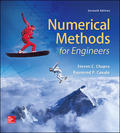
Apply the conservation of volume (see Prob. 1.9) to simulate the level of liquid in a conical storage tank (Fig. P1.11). The liquid lows in at a sinusoidal rate of
where low has units of

FIGURE P1.11
Want to see the full answer?
Check out a sample textbook solution
Chapter 1 Solutions
EBK NUMERICAL METHODS FOR ENGINEERS
Additional Engineering Textbook Solutions
Fundamentals of Differential Equations (9th Edition)
Advanced Engineering Mathematics
Basic Technical Mathematics
Precalculus: Mathematics for Calculus - 6th Edition
Precalculus: A Unit Circle Approach (3rd Edition)
- Q.1 Design a Mathematical Modelling for Pressure System with Two Resistances: Consider a pressure system with tank of volume V and varying pressure P at constant temperature. F1 is inlet flow through resistance R1 with source pressure P1. F2 is output flow through resistance R2 and flowing out at pressure P2. R2 R1 Tank -P2 P1 V, Parrow_forwardProblem 1: A fixed volume of ideal gas nitrogen is compressed in from State 1 to State 2 in a polytropic = const.). The conditions at each state are: process (PVn State 1: P1 120 kPa; T1 = 300K; V1 = 0.375 m3 State 2: P2 = 600 kPa; T2 400K Find the following quantities: The volume at State 2, V2 a. The numerical value of the polytropic exponent, n. b. The work, W. С. d. The heat transferred, Q.arrow_forwardFind the pressure difference between points A and B. (1,3,5,7,9): Liquid is Chloride with density 1490 kg/m³ and H = 25 cm. Liquid Oil (sg = 0.90) %3D 12 A cm 16 H 12 cm cm cm cm Mercury (sg = 13.54)arrow_forward
- Q2: The function relates the different variables in a capillary rise of a liquid is given by: h = f (d, g, ?, ?, ∅) where; h= capillary rise, d= tube diameter, ? = mass density, ? = surface tension; ∅ = contact angle Find a non-dimensionless expression relates h with the other given variables by using Buckingham theoremarrow_forwardA::V Gmail > A docs.google.com EE Q 3: A tank filled with oil,lf the total weight is(2 KN) and weight of tank only is (200 N) and volume of the tank is (190 L) , Find : Mass density ,specific weight ,specific gravity ,specific volume for the oil. 0.947 KN/m3,9.6534 kg/m3 , 0.01035 m3/kg , 9.65 94.7 KN/m3 ,96.534 kg/m3 , 0.01035 m3/kg , 1.965 9.47 KN/m3 ,965.34 kg/m3 , 0.01035 m3/kg , 0.965 Page 2 of 2 Back Submit Never submit passwords through Google Forms. This form was created inside of Mustansiriyah University. Report Abuse Google Formsarrow_forwardP1.26 When we in the United States say a car's tire is filled “to 32 lb," we mean that its internal pressure is 32 lbf/in above the ambient atmosphere. If the tire is at sea level, has a volume of 3.0 ft’, and is at 75°F, estimate the total weight of air, in lbf, inside the tire.arrow_forward
- Q.1 The barometer reads 740 mm of Hg, what would be the absolute pressure? Let intensity of pressure be 30 kPa and take specific gravity of mercury = 13.6 A 10.064 bar В 13.022 bar C C 4.59 bar D 1.28 bararrow_forwardSolve the following problems and sketch the schematic diagram describing the system. Show pertinent and complete solutions. A certain ideal gas X has molecular weight of 10 g/mol and specific heat ratio of 2. Initially, X has pressure of 200kPa and volume of 2m3. The pressure was doubled during heat transfer. Find the heat transfer if it underwent a process described by; a. n=infinity b. n=Cp/Cv c. n=3arrow_forwardA ship of 7500 tonnes displacement has KM 8.6 m, KG 7.8 m and 20 m beam. A quantity of deck cargo is lost from the starboard side (KG 12 m, and centre of gravity 6 m in from the rail). If the resulting list is 3 degrees 20 minutes to port, find how much deck cargo was lost.arrow_forward
- Find the value of Pressure (MPa), volume (m^3/kg), enthalpy, and internal energy if the T=321 ℃ and s=5.544kJ/(kg-K) (Note: 1. Show the data every table especially if the state of steam is superheated or subcooled)arrow_forwardThe figure belows shows a closed tank holding air and oil to which is connected a U-tube mercury manometer and a pressure gage, with L₁ = 2 ft, L₂ = 0.5 ft, and L3=1.75 ft. The densities of the oil and mercury are 55 and 845, respectively, each in lb/ft³. Let g = 32.2 ft/s². Pressure gage Pgage i Air Oil (p=55 lb/ft³) Determine the reading of the pressure gage, in lbf/in.² (gage). lbf/in.² Pam 43 Mercury (p=845 lb/ft³) 8= 32.2 ft/s²arrow_forwardThe mass of a fluid system is 0.311 slug, its density is 480 kg/m^3 and g is 31.9 fps. Find (a) the specific volume. Find (b) the specific weight.Find (c) the total volume.arrow_forward
 Elements Of ElectromagneticsMechanical EngineeringISBN:9780190698614Author:Sadiku, Matthew N. O.Publisher:Oxford University Press
Elements Of ElectromagneticsMechanical EngineeringISBN:9780190698614Author:Sadiku, Matthew N. O.Publisher:Oxford University Press Mechanics of Materials (10th Edition)Mechanical EngineeringISBN:9780134319650Author:Russell C. HibbelerPublisher:PEARSON
Mechanics of Materials (10th Edition)Mechanical EngineeringISBN:9780134319650Author:Russell C. HibbelerPublisher:PEARSON Thermodynamics: An Engineering ApproachMechanical EngineeringISBN:9781259822674Author:Yunus A. Cengel Dr., Michael A. BolesPublisher:McGraw-Hill Education
Thermodynamics: An Engineering ApproachMechanical EngineeringISBN:9781259822674Author:Yunus A. Cengel Dr., Michael A. BolesPublisher:McGraw-Hill Education Control Systems EngineeringMechanical EngineeringISBN:9781118170519Author:Norman S. NisePublisher:WILEY
Control Systems EngineeringMechanical EngineeringISBN:9781118170519Author:Norman S. NisePublisher:WILEY Mechanics of Materials (MindTap Course List)Mechanical EngineeringISBN:9781337093347Author:Barry J. Goodno, James M. GerePublisher:Cengage Learning
Mechanics of Materials (MindTap Course List)Mechanical EngineeringISBN:9781337093347Author:Barry J. Goodno, James M. GerePublisher:Cengage Learning Engineering Mechanics: StaticsMechanical EngineeringISBN:9781118807330Author:James L. Meriam, L. G. Kraige, J. N. BoltonPublisher:WILEY
Engineering Mechanics: StaticsMechanical EngineeringISBN:9781118807330Author:James L. Meriam, L. G. Kraige, J. N. BoltonPublisher:WILEY





